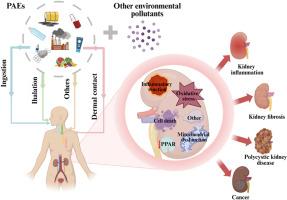邻苯二甲酸盐的叙述性综述:从环境释放到肾损伤
IF 7.3
2区 环境科学与生态学
Q1 ENVIRONMENTAL SCIENCES
引用次数: 0
摘要
塑料制品在人类日常生活中扮演着不可或缺的角色,很大程度上是因为它们的低成本和无与伦比的便利。邻苯二甲酸酯(PAEs)由于其独特的性能是最重要的塑料添加剂,被广泛使用和大量生产。然而,由于它们不能与塑料形成共价键,这些化合物很容易从塑料表面浸出。因此,各行各业使用的塑料已成为环境中PAEs的主要来源,导致对人类的风险增加。肾脏在PAEs的排泄中起着核心作用,被认为是PAEs积累和毒性的主要靶器官之一。越来越多的证据支持PAEs暴露与肾脏不良反应之间的联系。在环境中,PAEs经常与其他污染物同时暴露,这些污染物可能直接或间接地改变PAEs的毒性作用。本文综述了PAEs暴露对肾脏的不良影响及其作用机制,以及PAEs与其他污染物对肾脏的相互作用。这一综述强调了未来毒理学研究的必要性,以优先考虑PAEs和其他污染物共同暴露引起肾损伤的机制。采用先进的技术,包括网络毒理学和分子对接技术,是必要的,以加强了解潜在的毒性相关的共同暴露。本文章由计算机程序翻译,如有差异,请以英文原文为准。


A narrative review of phthalates: From environmental release to kidney injury
Plastic products play an indispensable role in human daily lives, largely due to their low cost and unrivaled convenience. Phthalates (PAEs) are the most significant plastic additives due to their distinctive properties and are extensively utilized and produced in large quantities. Nevertheless, given their inability to form covalent bonds with plastics, these compounds are prone to leaching from plastic surfaces. As a result, the use of plastics in various industries has become a major source of PAEs in the environment, leading to increased risks to humans. The kidneys, which play a central role in the excretion of PAEs, are considered one of the primary target organs for PAEs accumulation and toxicity. A growing body of evidence supports an association between exposure to PAEs and adverse effects on the kidney. In environments, PAEs are often exposed simultaneously with other contaminants that may directly or indirectly modify the toxic effects of PAEs. This review focuses on the adverse effects of PAEs exposure on the kidney and their mechanisms of action, as well as the interactions between PAEs and other contaminants on the kidney. This review underscores the necessity for future toxicological studies to prioritize the mechanisms of renal injury caused by co-exposure to PAEs and other pollutants. The employment of advanced technologies, including network toxicology and molecular docking techniques, is imperative to enhance comprehension of the potential toxicity associated with co-exposures.
求助全文
通过发布文献求助,成功后即可免费获取论文全文。
去求助
来源期刊

Environmental Pollution
环境科学-环境科学
CiteScore
16.00
自引率
6.70%
发文量
2082
审稿时长
2.9 months
期刊介绍:
Environmental Pollution is an international peer-reviewed journal that publishes high-quality research papers and review articles covering all aspects of environmental pollution and its impacts on ecosystems and human health.
Subject areas include, but are not limited to:
• Sources and occurrences of pollutants that are clearly defined and measured in environmental compartments, food and food-related items, and human bodies;
• Interlinks between contaminant exposure and biological, ecological, and human health effects, including those of climate change;
• Contaminants of emerging concerns (including but not limited to antibiotic resistant microorganisms or genes, microplastics/nanoplastics, electronic wastes, light, and noise) and/or their biological, ecological, or human health effects;
• Laboratory and field studies on the remediation/mitigation of environmental pollution via new techniques and with clear links to biological, ecological, or human health effects;
• Modeling of pollution processes, patterns, or trends that is of clear environmental and/or human health interest;
• New techniques that measure and examine environmental occurrences, transport, behavior, and effects of pollutants within the environment or the laboratory, provided that they can be clearly used to address problems within regional or global environmental compartments.
 求助内容:
求助内容: 应助结果提醒方式:
应助结果提醒方式:


